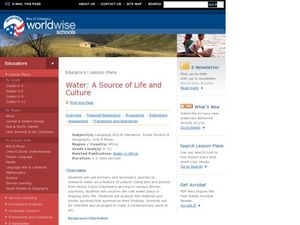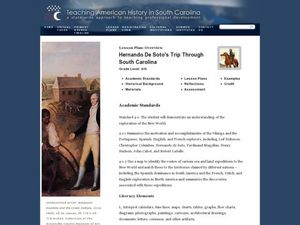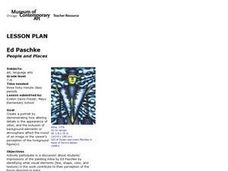Curated OER
My Story and History: Peeking into the Past with Paintings
Consider how you can use a visual source, such as a painting, to learn about a historical time or event. Young learners discuss primary sources and how they differ from secondary sources, then analyze the painting Mother and Child by...
Curated OER
Real-Life History: Looking at Our Community
Spend several days with your class exploring local history. Learners brainstorm and categorize sources of historical information as primary or secondary; collect and present artifacts from family/community; construct a definition of...
Curated OER
Primary Sources and Protagonists: A Native American Literature Unit
Introduce your middle schoolers to the lives of past Native Americans. First, learners work together to put photographs in a sequence. Then, using their sequence, they create stories to share with the whole class. No matter how old your...
Maryland Department of Education
Our Children Can Soar
Amazing efforts of African American leaders are celebrated in a lesson on civil participation. The engaging resource focuses on primary and secondary sources to analyze the impact of African American leaders such as Ella Fitzgerald....
Curated OER
Be a Sourceerer's Apprentice
Students examine and discuss various primary and secondary sources. They bring in an example of a primary source, explain how it is a primary source, and complete a worksheet about interviewing a primary source.
Curated OER
Sources of Information
Students review information from a previous lesson about JFK and his assassination. As a class, they identify sources they believe historians use and describe the difference between a primary and secondary source. In groups, they...
Curated OER
Historians Interpret Sources
Students read excerpts from the historian Conover Hunt writing about John F. Kennedy and from primary source documents using the handout: Historical Sources and Historians. Students discuss and identify source types, evaluate sources,...
Curated OER
Water: A Source of Life and Culture
Students explore water as a feature of culture. In this visual arts lesson, students consider the necessity of water in every culture. Students select water symbols and use their artistic skills to create water symbol silhouettes.
Curated OER
Hernando De Soto's Trip Through South Carolina
Fourth graders become familiar with the explorations of Hernando DeSoto. In this DeSoto lesson plan, 4th graders recognize the routes and territories of DeSoto's explorations. Students use primary and secondary sources and research to...
Curated OER
Student Newspaper Project
Writing teaches us so much. One can identify the many characteristics of a newspaper, use the Internet to gather information, and communicate with others. Primary students create a class newspaper for publishing and dispersal.
Curated OER
Critical Reading, Imaginative Writing and the Montage
Students discuss the difference between primary and secondary sources and consider how an exhibit is researched. They design and create a montage that reflects themselves in a social and historical context.
Curated OER
Feminism Does Not Have to be an F-Word
Learners analyze social activism messages in music. In this feminism lesson, students explore selected music that expresses sentiments voiced in the women liberation movement in the United States. Learners compare the lyrics of the songs...
Curated OER
Red is the Word!
Through the use of stories, artwork, and the KidPix program, youngsters explore the color word red, and engage in activities around the word. Teaching kindergartners about the color words can be so much fun. This could be adapted for any...
Curated OER
Light and Shadow
Students compare and draw items with shading based on where a light source is in relation to the object.
Curated OER
Crossing the Delaware with Historic, Cultural, and Personal Interpretations
Sixth graders discover the importance of information sources by researching the United States History. In this research gathering instructional activity, 6th graders examine a historical painting of George Washington and analyze...
Curated OER
People and Places
Fifth graders investigate how the geography of the land effected the human experience of the Lewis and Clark Expedition. They research using primary and secondary sources, design a map.
Curated OER
Diversity of Colors
Young scholars investigate color diversity by experimenting with jelly beans. In this color spectrum lesson, students observe colored jelly beans through different filters and light sources to change the existing look of the bean....
Curated OER
The Civil War through a Child's Eye
Students read Paul Fleischman's Bull Run in Readers Theater format. Next, students examine and interpret primary source images of Civil War era students and reveal their understanding of a child's perspective in a literary portrait.
Curated OER
Research as a Historian, as an Artist
High schoolers work together to research one area of history that is of an interest to them. Using primary sources, they examine photographs and disuss what they already know about the topic. They present their images and information...
Curated OER
Illustrated Letters
Learners role play the role of a famous artist living during the 1800s. They write a letter to their friend explaining the impact of this artist on others. In groups, they read primary source documents to examine life during the 1800s.
Curated OER
That Was Then
Students compare and contrast their community in the past and today. Using primary sources, they develop their own history of their community. Individually, they create maps of the local area and complete sketches of local gravestones.
Curated OER
A Presidential Portrait: Andrew Jackson
Eighth graders examine the role of intended meaning in Ralph Earl's portrait of Andrew Jackson. They, in groups, research periods in Jackson's life and use gathered information to create their own portraits of Jackson.
Curated OER
Shakespeare: Standing on the Bookshelves of Giant
A phenomenal lesson on Shakespeare! Middle and high school learners create WebQuests about the texts and authors that Shakespeare himself studied when he was in grammar school. They use a variety of media in order to create dramatic...
Curated OER
Comparing Visual Interpretations and Actual Events: War & Battle
A Venn Diagram is used to compare artistic and historical representations of a single event. Young analysts view the provided images, read textbook descriptions, and discuss the validity of each representation in terms of bias and...























